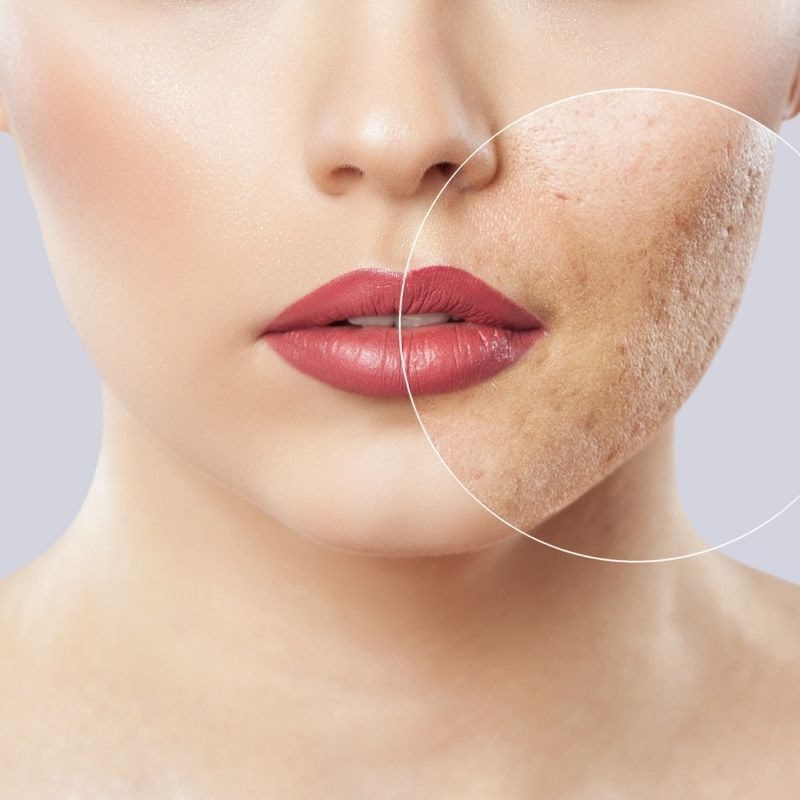Open Pores
What Are Open Pores?
Open pores refer to enlarged skin pores that become increasingly noticeable over time. These pores, which allow the skin to “breathe” by releasing sebum or natural oils, can appear larger in areas with a higher concentration of sebaceous glands, such as the T-zone of the face. Open pores can affect skin texture, becoming a cosmetic concern for both men and women, particularly those with oily or combination skin types.
This skin issue is common among teenagers experiencing hormonal changes and adults dealing with aging skin or hormonal imbalances. Understanding what causes open pores is the first step in addressing them. Explore effective treatments and preventive measures to minimize their appearance and improve your skin’s overall look and feel.
Causes
What Causes Open Pores on the Face?
Here are the primary reasons behind the formation of open pores:
- Excessive Sebum Production: For individuals with oily or combination skin, an overproduction of sebum can cause hair follicle openings to enlarge, making pores appear larger.
- Increased Hair Follicle Volume: Hair follicles are tubular structures, and those with thicker follicles have larger openings. These can expand further to accommodate excess oil, resulting in noticeable open pores.
- Genetics: Heredity and ethnic background play a significant role in determining pore size. Genetic predisposition can make some individuals more prone to having larger pores.
- Aging and Sun Exposure: As skin ages or is damaged by sun exposure, collagen and elastin fibers weaken. This loss of strength and elasticity can cause pores to appear more pronounced and crater-like.
- Chronic Acne: Acne-prone skin often leads to clogged pores and the formation of blackheads and whiteheads. Inflammatory acne can further damage sebum glands and follicular openings, enlarging pores.
- Skin Conditions and Nutritional Deficiencies: Rare conditions such as chronic radiodermatitis and deficiencies in nutrients like vitamin A can also contribute to enlarged pores.
Diagnosis
How to Diagnose Open Pores
Diagnosing open pores involves a combination of self-assessment, clinical examination, and, in some cases, advanced dermatological techniques. Here’s how you can identify and diagnose open pores:
1. Self-Assessment
Visual Inspection: Examine your skin, especially the T-zone (forehead, nose, and chin) where open pores are most common. Look for enlarged, visible pores that appear more pronounced than the surrounding skin.
- Feel the Skin: Gently touch your face. Open pores often feel rough or uneven to the touch, especially when compared to smoother areas of the skin.
- Observe Oiliness: Individuals with oily or combination skin are more likely to have open pores. Notice if your skin feels greasy or if you frequently experience excess oil production.
2. Self-Assessment
- Dermatologist Consultation: Schedule an appointment with a dermatologist for a professional evaluation. They can provide an accurate diagnosis by visually inspecting your skin and evaluating your skin type and condition.
- Skin Analysis Tools: Dermatologists may use specialized tools such as magnifying lamps or dermatoscopes to get a closer look at the pores and assess their size and condition.
Treatment
Advanced Open Pores Treatment By Dermatologist in Kolkata
Enlarged open pores can be challenging to treat due to various underlying factors. Leading dermatologist in Kolkata at La Derma Clinic use a combination of medical treatments and advanced aesthetic procedures to provide visible results. They focus on addressing primary triggers by controlling excessive sebum production and minimizing skin damage caused by aging.
Here are some of the best treatments for open pores:
Laser Toning
Top doctors at La Derma Clinic specialize in advanced laser toning treatments for open pores using USFDA-approved technology. The Q-switched Nd laser is used to exfoliate the skin, stimulate collagen production, reduce oiliness, and minimize the appearance of pores. Dermatologists recommend 6-8 sessions with a 3-4 week interval between each session for optimal results. Clients may also need maintenance sessions to sustain the results for a longer time. This procedure has no downtime.
Laser Skin Resurfacing
Dermatologists use Fractionated Erbium YAG laser to create micro-injuries on the top layer of the skin, inducing a healing response by stimulating collagen production and tightening the skin. This procedure effectively removes lines and reduces the visibility of pores. It has a downtime of 5-7 days and requires the application of topical anesthesia before the procedure. The results are long-lasting.
Micro-needling radiofrequency (MNRF)
La Derma Clinic offers microneedling radiofrequency treatment for open pores. This treatment involves inserting tiny microneedles into the upper layer of the skin and releasing radiofrequency energy. This triggers the skin’s healing response by stimulating collagen and elastin production, resulting in reduced visibility of enlarged pores. Doctors recommend 6-8 sessions with a few weeks between each session. The procedure has no downtime, and the results are long-lasting.
Chemical Peels
The medical team at La Derma Clinic recommends salicylic acid peels and glycolic acid peels for controlled exfoliation of dead skin cells. These peels help control excess sebum production and promote skin renewal, further removing pore clogging and controlling inflammation. Chemical peels are an effective treatment for reducing large skin pores. Individuals may require a few sessions with a 2-4 week gap between each, along with regular maintenance for the best results.
By combining these advanced treatments, dermatologists at La Derma Skin Clinic can effectively reduce the appearance of enlarged open pores and improve overall skin texture.














